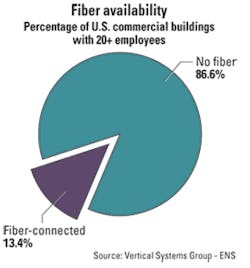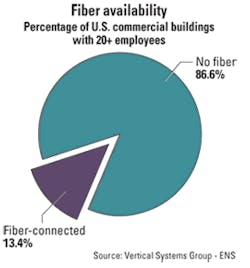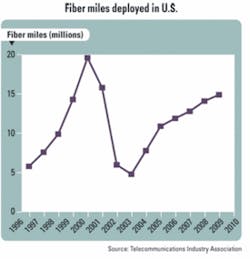by Greg Gum
Since its inception in 1973, Ethernet has evolved into a highly reliable technology that has been embraced by the industry for both LAN and WAN applications because it is ideally suited for scaleable, cost-efficient transport of IP traffic. Meanwhile, fiber optics has paved the way for increasingly faster data pipes to carry traffic stimulated from the acute rise in broadband for high-speed Internet access.
Continued growth of bandwidth, richer media applications, better and cheaper technology -- all sounds good, right? But hang on; Fig. 1 paints a scary picture. Even with consumer broadband penetration rates hovering around 65% in the U.S. and considering advances in fiber optics, semiconductors, microprocessors, etc., the percentage of businesses that are actually connected to fiber today according to telecom and analyst firm Vertical Systems Group is frightfully low.
In fact, according to recent statistics published by the Telecommunications Industry Association (TIA), fiber penetration rates have not increased significantly even during the boom years for telecom just before the market "bubble" burst after 1999 (Fig. 2).
So, in effect, although U.S.-based fiber deployments have more than doubled in the past two years due to IPTV, quadruple play, etc., approximately only 2% of U.S. broadband subscribers are directly connected via fiber and less than 13.4% of businesses. (ILECs drove 86% of the growth from 2003 to 2005 for IPTV strategies, according to the TIA 2006 Telecommunications Market Review and 2006 OECD data.)
So what will further drive deployments of fiber and allow connectivity to the existing fiber to provide an answer to the need for speed?
The next boom?
Carrier Ethernet has generated the next "buzz" in the technology industry as carriers attempt to accommodate the rapid growth and bandwidth consumption from new IP-based applications. The Metro Ethernet Forum (MEF) projects that Carrier Ethernet-based business services alone will grow to nearly $31 billion by 2012. Several key drivers will generate this growth:
- Inexpensive, widely available chips due to volumes for PCs and other appliances.
- Ethernet as the de facto standard for wireless and wireline LANs.
- The ability to converge all applications on to a single transport media inexpensively.
- Emerging standards for even higher speeds of Ethernet: 10G, 40G, 100G, and now the promise of Terabit Ethernet.
- Growth in data traffic over wireless mobile data infrastructure, e.g., 3G/4G LTE deployments and new multimedia-focused iPhone-type handsets.
- The rapid rise in bandwidth-intensive applications such as streaming video, point-to-point, viral video-focused services like YouTube, and mobile data-based applications.
Given such rapid growth rates and market dynamics, what's next for Carrier Ethernet?
The immediate challenge to the realization of Carrier Ethernet 2.0 is better end-to-end visibility and overall management and provisioning across these new high-speed Ethernet circuits. The result should be similar to what has already been done in the traditional SONET/SDH world to take advantage of both the existing and new fiber-optic network infrastructure.
Significant innovation is occurring around Ethernet operations, administration, and maintenance (OAM) capabilities and quality of service (QoS). Guidelines such as 802.1ag, 802.3ah, Y.1731, RFC2544, and MEF 14 and 17 will enable better diagnostics, troubleshooting, and management for more robust and reliable use of Carrier Ethernet in the WAN.
These new standards have been developed to help ensure end-to-end service continuity in the case of 802.1ag and Y.1731 (Fig. 3), while 802.3ah provides for adjacent link continuity from node-to-node. MEF 16 or E-LMI enables service awareness for network interface devices (NIDs) for configuration and customer notification. The basic user-to-network interface or MEF 9 UNI certification provides a common interface specification between the carrier network and subscriber network. Implementation of these standards across an Ethernet network enables carriers to better provide customers end-to-end visibility, notification, link diagnostics, and sectionalization of where problems may occur.
A second key area of focus has been the overall management and control plane capabilities that enable Ethernet service providers to rapidly order, provision, and bill for their Ethernet services. Historically, carriers in the U.S. had common systems and processes due to the vestiges of the former Bell System and organizations such as Bellcore and Telcordia that were established to set standards and develop common back-office systems and tools. With the breakup of the Bell System and the move to lessen carriers' reliance on legacy billing and provisioning systems for newer IP-based services, management systems have been largely either custom developed or bridged together with existing legacy systems. Consequently, most carriers have experienced long service turnup and lead times and time-consuming operational support systems (OSS) integration issues as they rapidly try to roll out new Layer 2/3 Ethernet-based IP services.
Solving this network management puzzle has been difficult for several reasons:
- Networks are inherently multivendor. Most if not all carrier networks have several vendors' equipment for best-of-breed architectures. Management systems for most of these systems are proprietary and only manage the network elements they came with, necessitating integration of several element management systems from multiple vendors.
- Too many systems to integrate into the back office. In addition to integrating multiple network elements, each major management software package typically must be interfaced into existing northbound OSS order entry and billing systems to enable flow-through ordering and provisioning of services.
- Accommodating rapidly evolving standards and features. New functionality and evolving standards such as OAM may not yet be integrated into all elements within the network, thus mitigating end-to-end management benefits to only those network elements that support it.
- Scalability. There are few systems today that support full fault, configuration, accounting, performance, and security (FCAPS) management functionality and control plane capabilities within a single management system while scaling across large multivendor, multidomain networks.
Given recent carrier consolidation and the merging of networks due to M&A activity, these problems have only worsened over the last decade. Thus, carriers have struggled to keep up with the pace of new technologies and the rapid integration of these capabilities into their OSS systems to roll out new service offerings.
Several options have emerged recently to assist in these areas. In addition to the OAM standards work, the MEF has initiated MEF 15, which outlines requirements for management of metro Ethernet network elements. These guidelines are being closely followed by several new entrants in the Carrier Ethernet space. The result is a focus on end-to-end management software and tools for enabling carriers to rapidly develop, deploy, provision, and bill for new services across a carrier's new Ethernet transport network.
Also addressing these concerns, the TeleManagement Forum (TMF; www.tmforum.org) has also proposed several standards in this area. Most notably of these is Multi-Technology Operations Systems Interface (MTOSI), which is a standard that provides the "glue" to connect different vendors, technologies, and systems together within the network. MTOSI will ease the integration burden and allow operators to fully focus on developing and delivering new services to market.
The MTOSI interface standard enables solutions providers to address the problem of handling complex multivendor network adapters for disparate equipment and systems. It provides common specifications using standard XML-based interfaces to interconnect both northbound and southbound OSSs, network management systems, and multivendor network elements.
Companies such as Soapstone Networks, Nakina Systems, Gridpoint, Telcordia-Granite, IONA, and several equipment manufacturers such as Cisco (ANA management solution), Alcatel Lucent (SAM), Nortel (MEMS), Ciena (ONCenter), and ANDA Networks (EtherView) provide and/or are moving to provide better management software for large multivendor-based Carrier Ethernet networks on an end-to-end basis.
So when it comes to Carrier Ethernet network visibility, can we finally see the forest for the trees? While much has yet to be done to accommodate the insatiable bandwidth appetite of consumers and businesses, innovation continues. The explosive Carrier Ethernet 2.0 market is yet another example of that innovation. Clearly standards groups, key industry players in both software and hardware, and service providers are stepping up to the challenge of this highly explosive $31 billion service market. More importantly, the "trees" seem to be bearing financial fruit with the potential for the next multibillion dollar forest called Carrier Ethernet.
Greg Gum is vice president, marketing and business development for ANDA Networks.



